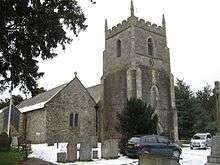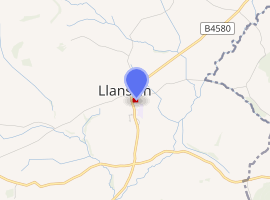St Silin's Church, Llansilin
St Silin's Church is a parish church in Llansilin, Powys, Wales. The present building, which has parts dating back to the 13th century, is a Grade I listed building.[1] It stands on a site that has been used by Christian communities since the Dark Ages. The church is dedicated to Saint Silin, now better known as Saint Sulien, the 6th-century founder-abbot of a monastery at Luxulyan in Cornwall.
| Eglwys San Silin | |
|---|---|
| Church of St Silin, Eglwys Sant Silin | |
 | |

| |
| Location | Llansilin, Powys |
| Country | Wales |
| Denomination | Church in Wales |
| Previous denomination | Church of England |
| History | |
| Status | open |
| Architecture | |
| Heritage designation | Grade I |
| Administration | |
| Parish | Llansilin |
| Diocese | St Asaph |
St Silin was the only parish in the Welsh Marches on the England–Wales border that voted to leave the Church of England under provisions of the Welsh Church Act 1914 that led to the creation of the Church in Wales.
History
The church was constructed out of wood in a cruciform shape as a Clas, though it was damaged during Owain Glyndŵr's rebellion and the nave was rebuilt in stone.[2] A 13th-century lancet remains a part of the current building.[1] During the English Civil War, Oliver Cromwell's Roundheads used the church as a barracks and the south door for target practice with muskets. It was also shot at by Royalist forces sieging the church; the door is still in use and still retains the bullet holes.[2][3] The wooden spire of the church burned down in the 1800s and a replacement stone tower was built in 1832.[2]
Parish
St Silin's Church serves the Welsh parish of Llansilin in the Diocese of St Asaph.[4] Part of the parish crosses the England–Wales border to include part of the English county of Shropshire owing to boundary changes made by King Henry VIII in 1536.[3][5] As a result of the ecclesiastic border crossing the temporal border, in 1915 the Welsh Church Act 1914 classed Llansilin as one of 19 border parishes, meaning that residents of the parish were entitled to take part in the Church of England border polls 1915–1916 to determine if they wished to stay with the established Church of England or join the newly disestablished Church in Wales. The referendum results for 17 of the 19 parishes were published in the House of Commons, all in favour of remaining part of the Church of England. However, in the parishes of Llansilin and Rhydycroesau, the result was considered too close to call. A second poll was therefore held in 1916; Llansilin voted to join the Church in Wales by 255–228, becoming the only parish in the referenda to do so.[6] As a result, the parish contains a part of England that is under the jurisdiction of the Church in Wales instead of the Church of England.[7][3][8]
Listed building
St Silin's Church was granted Grade I listed status in 1966. The reason given for the listing was because the church was "preserving unusually fine 15th Century and some earlier fabric, plus important post-mediaeval features, and which has undergone sensitive restoration by Baker in the 19th Century leading to a result of exceptional character."[1]
References
- "Church of St Silin – Llansilin – Powys – Wales". British Listed Buildings. 1966-04-01. Retrieved 2016-09-22.
- "Church spotlight: St Silin's Church in Llansilin". Shropshire Star. 2015-09-20. Retrieved 2016-09-22.
- "St Silin's Church" (PDF). Meini Bywiol Living Stones Heritage. Retrieved 2016-09-22. Cite journal requires
|journal=(help) - "Plygain Service – Llansilin – The Diocese of St. Asaph". Church in Wales. 2013-12-06. Retrieved 2016-09-22.
- "Llansilin, St. Silin". GENUKI. Retrieved 2016-09-22.
- "The Historical Background to the Marriage (Wales) Act 2010" (PDF). University of Reading. Retrieved 2016-09-22. Cite journal requires
|journal=(help) - "History of Sychtyn, in Oswestry and Shropshire". Vision of Britain. Retrieved 2016-09-22.
- "St Silin's Church, Llansilin". Mathrafal Deanery. 2014-11-11. Retrieved 2016-09-22.